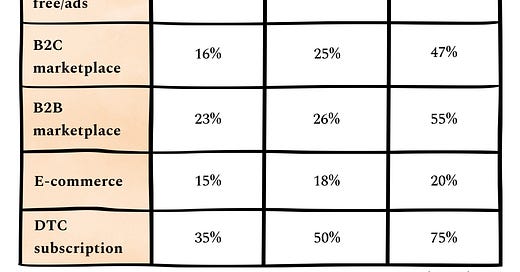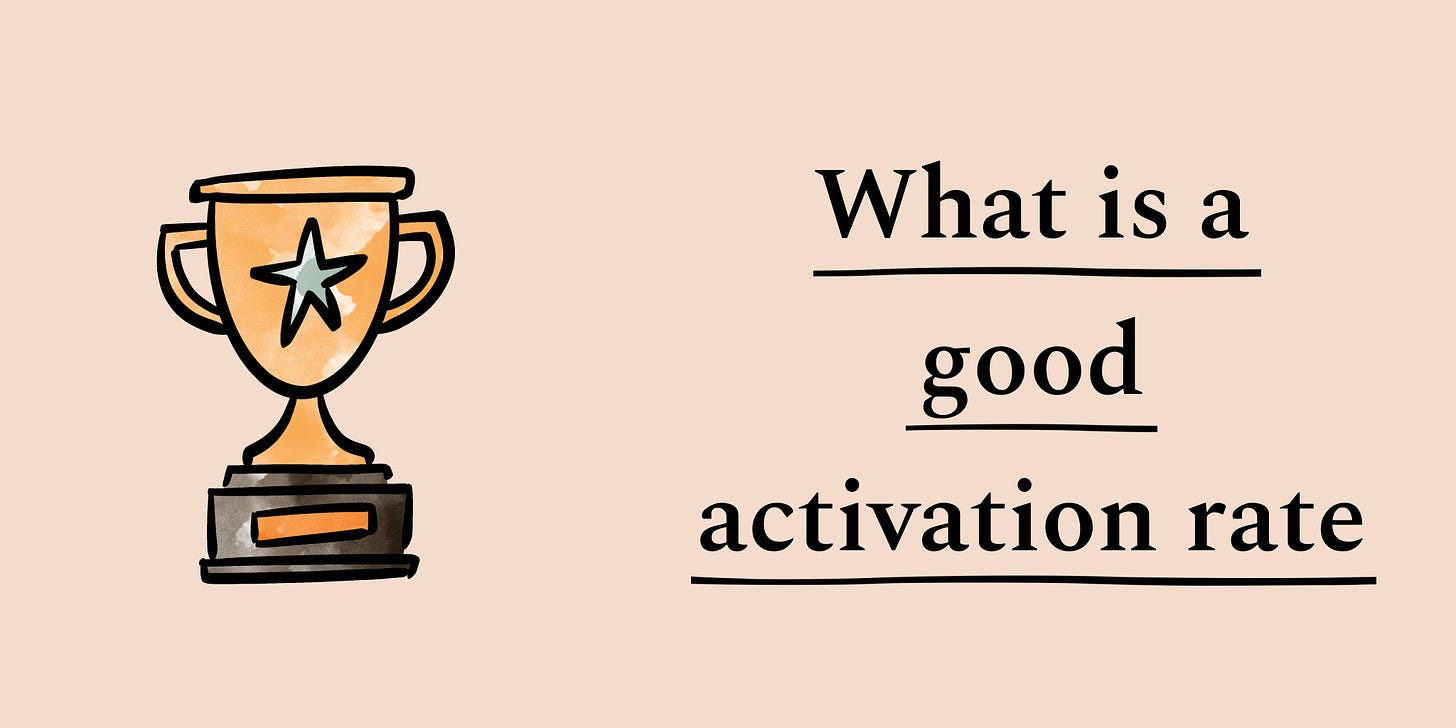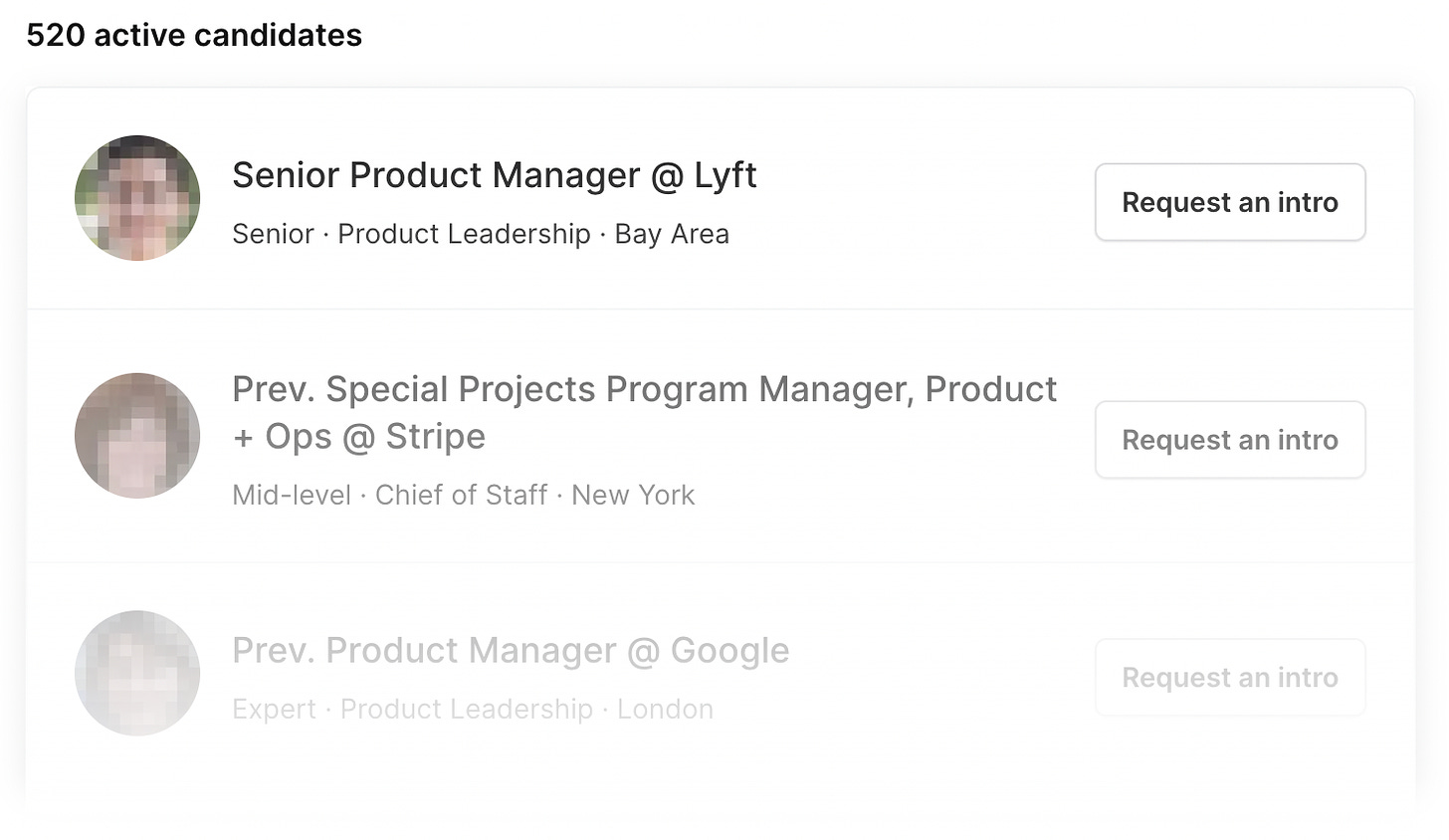What is a good activation rate
Benchmarks and advice for increasing your activation rate, based on a survey of 500+ products
👋 Hey, Lenny here! Welcome to this month’s ✨ free edition ✨ of Lenny’s Newsletter. Each week I humbly tackle reader questions about product, growth, working with humans, and anything else that’s stressing you out about work.
If you’re not a subscriber, here’s what you missed this month:
Subscribe to get access to these posts, and every post.
Q: What is considered a good activation rate?
Increasing activation rate is one of the highest-leverage growth levers across most products, and it’s often the single best way to increase your retention. But knowing what a good activation rate is, and how to improve it, has been difficult if not impossible. For that reason, it’s been one of the most frequent questions I’ve received from readers over the years.
To finally get you an answer, I teamed up with Yuriy Timen (growth advisor and recent podcast guest) to run a global benchmarking survey, asking readers to contribute their activation rate and what they’ve learned about increasing it. We exceeded our expectations and ended up with over 500 responses, which I believe is the largest survey of its kind. Here’s a sampling of products represented in this survey:
Below, you’ll find GOOD and GREAT activation rates (by product type), the most common ways to increase activation rates, examples of great activation milestones, and a bunch of advice for setting and improving your activation rates.
We did our best to analyze this data and draw conclusions, but I’m confident we missed something. If you find anything amiss, please let us know by leaving a comment. We’ll integrate feedback and update the post with any additional learnings 👇
And finally, if you filled out our survey and shared your activation rates with us, you should have received an email with a link to the raw survey data. If you didn’t get that email, please let us know and we’ll get it right over to you. If you missed the boat and didn’t contribute to the survey but still want to see the raw results, at the end of this post there’s a second opportunity.
Let’s get into it.
1. What is activation rate?
Your activation rate is the percentage of your new users who hit your activation milestone. Concretely:
activation rate = [users who hit your activation milestone] / [users who completed your signup flow].
Your activation milestone (often referred to as your “aha moment”) is the earliest point in your onboarding flow that, by showing your product’s value, is predictive of long-term retention. A user is typically considered activated when they reach this milestone.
A good activation event is often associated with the beginnings of a user forming a new habit inside the product, and since increasing activation rate is one of the best levers for increasing retention, it’s often a major focus for growth teams.
2. What are examples of activation milestones?
A good activation metric should be two things:
Highly predictive: It should be predictive of long-term value delivery to the user, which often manifests itself in long-term retention, monetization, or both. Users who hit your activation milestone should retain at a rate at least 2x better than those who do not complete the activation step.
Highly actionable: The metric needs to be something growth teams can directly impact. For example, for a multi-user SaaS products (e.g. Figma), teams often set their activation metrics on workspace- or account-level actions (e.g. “workspace with 10 items created and 2+ active editors by W4”) vs. a user taking action. You can’t make a workspace or an account do anything—only users can.
In the survey, we looked at activation rates by eight product types:
B2B enterprise SaaS (e.g. Salesforce, Workday)
B2B prosumer SaaS (e.g. Figma, Slack)
B2C freemium/subscription (e.g. Duolingo, Calm)
B2C free/ads (e.g. Snap, Instagram)
B2C marketplace (e.g. Airbnb, eBay)
B2B marketplace (e.g. Faire)
E-commerce (e.g. Chewy, Wish)
DTC subscription (e.g. Hims, Athletic Greens)
Below are some of the most common activation milestones, categorized by product type:
A few of our favorite examples of activation milestones:
First day of food and weight logged
First 5 survey responses collected
First design published and shared
First video created that received a view
First listen to more than 40% of a track
First listen to 3+ sessions in the first week
First time booked listing
First moved meeting
First job application sent
10 posts published in first 2 weeks
Below we’ll share the most common mistakes when setting your activation milestone, but by far the most common mistake is to set the activation point too early or too late. Too early would be simply finishing the sign-up process for a SaaS product, and too late would be three purchases in a marketplace or e-commerce site.
Activation is meant to be a leading indicator of a new user sticking around and becoming a customer—not the act of becoming a long-term customer. It’s meant to be something your team can do to increase retention, and defining activation as either sign-up or multiple purchases defies the purpose behind an activation metric.
3. What is a good activation rate?
Based on our survey results, broadly, the average activation rate is 34%, and the median activation rate is 25%.
For just SaaS products (removing marketplaces, e-commerce, and DTC), the average activation rate is 36%, and the median is 30%.
Here’s what activation rates look like by individual product types:

Why such variance in activation rates?
Mostly due to the milestone definition, and how much effort it takes to get there.
For example, marketplaces and e-commerce companies have the lowest activation rates because they generally define their activation milestone as the first transaction (i.e. spending money). B2C freemium products have the highest activation rate because their typical activation milestone is low-friction (e.g. starting a meditation session, logging a meal, listening to a music track).
4. What are the most common ways to increase activation?
In our survey, we asked, “If you’ve had success improving activation rate, what change has had the biggest impact?”
Here are the eight most commonly referenced tactics:
Here are direct quotes from survey responders sharing what most helped them increase their activation rate:
i. Simpler onboarding UI/UX
“Removing distracting CTAs between sign-up event and activation event”
“Hiding a confusing button on home page for new users”
“Simplifying the flow”
“Simplify setup process”
“Simplify the flow to make a first booking”
“Changed the flow to have fewer steps and improved it 20%”
“Reducing number of steps”
“Removing unnecessary steps, calming anxieties at each stage”
“Break down the core steps to simplify booking flow”
“Reducing the number of steps during onboarding”
“Reduce steps to onboarding flow”
“Reducing the steps required in the onboarding flow”
“Reducing multiple steps in onboarding flow”
“Reducing steps in the onboard flow”
“Shorten funnel”
“Shorten steps”
“Simplifying the onboarding process and requirements”
“Focused onboarding—improving relevance of the features we expose to the customer”
“Driving all attention into one seeded task for guided completion”
“Order of how tasks are presented made the biggest difference”
“Breaking down the learning curve to 3-4 actionable steps and guiding them through it in the product”
“Simple, mobile-optimized sign-up flow”
“Don’t allow the user to do anything before the group is created”
ii. Reducing onboarding friction
“Making smart recommendations/defaults”
“Pre-populating user journeys with relevant content based on job title”
“Adding search suggestions in onboarding flow”
“Automatic suggestions”
“Adding several authentication providers (FB, Google, Apple)”
“Adding Apple login”
“Adding additional payment methods”
“Autofetch of information to reduce burden on user to supply information”
“Made the doc creation screen more visible”
“Less words to reduce friction to just start”
“Removing login gate from initial app interactions”
“Creating options that require fewer authentication into third-party platforms”
“Reducing friction of the connection/setup process and building more if/then steps into the connection flow to specially handle common errors like incorrect physical installation, Wi-Fi setup problems, etc.”
“Adding the modals after each completed step that redirect a user to the next step required for activation”
“Login immediately after sign-up”
“Changing that page to the default home screen on the app”
“Improved accessibility”
“Reducing early friction”
“Deep-linking”
“Providing alternative ways to connect an account”
“Offering more pathways toward key actions”
“Removing obstacles in onboarding—improving time to value”
“Templates and pushing users to start a design with the right template”
“Creating templates that get users started easily”
“Metric spiked after introducing templates to choose from in the onboarding flow”
“Linking to the actions from the dashboard (first page they see)”
“Sending new subscribers on an onboard flow that first urges them to complete the download”
iii. Emails and follow-up comms
“Email drip sequences with how-to videos”
“Email sequencing with more value rather than a simple reminder”
“Automated email asking for the details after they’ve registered”
“Focused nurturing over their first 3 months on the referral program”
“Outbound messages right after activation”
“Sending follow-up emails”
“Lifecycle comms”
“A WhatsApp message with the next steps and their basic information”
“Sending SMS after completion of a match”
“Email welcome series”
“Email automations”
“Push notification prompts”
“Push notifications with personalization for new users”
“Sending more push notifications off the back of writing shorter content”
iv. Optimizing copy
“Copywriting”
“Onboarding copy”
“Better landing pages”
“Clearer value prop to the customer”
“Improving onboarding education”
“Week 1 educational content”
“Educational changes in the onboarding flow”
“More education in onboarding and helping users through customer success interventions”
“Clearer communication with customer on what requirements they need to have ready to start onboarding”
“Giving them clear and understandable information”
“Better getting-started documentation/onboarding”
“Redoing our onboarding messaging”
v. Smarter top-of-funnel targeting
“Limiting who can sign up”
“Better initial selection of target audience”
“Better qualification”
“Improving the quality of leads at the top of funnel, shifting away from Facebook to Indeed for finding applicants”
“Activation segmentation to characterize users who are initially more ‘activated’ ”
“One-on-one recruiting”
“Better product education during sign-up on who we are not for”
“Block customers who do not fit our ICP profile to register on our platform”
“Going after power users”
“Bringing in higher-quality leads”
“Better qualifying users while signing up”
vi. Sales outreach
“Doing things that don’t scale. One-on-one Zoom onboarding with clients”
“Leveraging our sales team to make calls to customers”
“Personal outreach from the sales team”
“Personal onboarding”
“White-glove onboarding”
“Having a phone call with the prospect”
“We called everyone who did not complete the onboarding process to complete it”
“Personalized onboarding by an account manager”
“Concierge onboarding (phone call)”
“One-on-one communication”
“A ‘welcome to service’ call and instructing them to set up”
vii. Adding incentives
“Offering financial incentive”
“First-booking discounts”
“Special offers”
“First-order incentive; free shipping”
“Product discounts, shipping discounts”
“Welcome discount”
“Use discounted products to drive first sales”
“Shipping discounts”
viii. Showing value earlier
“Onboarding that more directly enabled the most popular JTBD”
“Getting users into the content catalog as quickly as possible”
“Revamping onboarding to make it easier for the users to understand the benefits”
“Making our best-known feature not require configuration to try”
“Showing core product value as early in the funnel as possible”
Other:
Personalization
“Personalized product tour depending on user’s goal”
“Personalized onboarding and recommendations”
“Personalize first product experience based on user profile/interests”
“Customized pitch to every potential client”
Checklists
“Dashboard with checklists and help resources (our solution is all-in-one and there are lots of features, so it takes time for new users to adopt the main ones; that’s why they need additional resources)”
“Embedded checklists”
“Adding guided onboarding to the product with a checklist and limiting the number of actions for users at the beginning of their journey”
“Adding an onboarding section describing the steps needed to activate”
Social proof
“Social proof/create peer confidence”
“Testimonials on checkout page”
“New content with high-profile instructors”
“User reviews”
Marketplace dynamics
“Adding supply”
“Limiting supply entering the marketplace. Too much supply for too little demand meant less activation”
Dedicated resources
“A team dedicated to onboarding”
“Hiring more people to build out additional tests, new page design, additional labor to process leads”
“Improving install speed”
“Dropping users in the community directly after onboarding”
“Building features to collaborate with colleagues that led to more users from the same company being engaged”
“Adding multiple KYC providers”
“Creating a sense of urgency”
“Gamification”
“Video demos”
“Changing the length of the free trial”
5. What are the most common mistakes people make when setting their activation milestone?
Too early: Often companies define activation as simply completing the sign-up flow, which alone is unlikely to show a user the value of your product, and thus is unlikely to be predictive of long-term retention.
Too late: Marketplaces and e-commerce startups often mistakenly consider “activated” to be when users make multiple purchases. Your activation milestone should be a leading indicator of having built a habit, not having proven the habit.
Not predictive: Selecting an activation metric that’s not highly predictive (i.e. at least 2x) of long-term retention and/or monetization.
Not actionable: Selecting an activation metric that’s not easily actionable (e.g. see workspace example above), measurable (e.g. using an offline event that digital growth teams can’t impact), or hard to experiment with (e.g. takes three months to get any data).
Too complicated: Selecting a multi-stage activation event with multiple different user actions, along with a time bound, where a simpler definition would give you most of the predictability you get with the overly complex definition.
6. What percentage of companies have a time-bound activation definition?
Based on our results, about 6% of respondents had time-bound activation, with a median of 10 days and a mode of 7 days. We believe, however, that this is far undercounting the reality, as we didn’t specifically ask about it.
Also, about 10% of respondents have a two-part milestone (e.g. get 2+ bookings within 7-day time frame; share 3 documents in 90 days).
7. How do you determine your activation milestone, and make sure it’s causally linked to new-user retention rather than just correlated?
Initially, your selected activation event will be hypothesis-driven and hence only correlative to longer-term retention and/or monetization. That’s OK. Take your best shot. It is only through structured experimentation that you will be able to tell if there is a causal relationship between your activation metric and longer-term value extraction.
Specifically, you would run a series of experiments geared at improving your activation metric. As you accumulate winners, you will monitor your later-stage metric to see if they uptick as well. If so, you have proven out causality. If not, you have the arduous task before you of going back to the drawing board and iterating on your definition of an activation metric.
Our advice is to not overthink it—pick a milestone that’s relatively early in a new user’s lifecycle that strongly correlates with long-term retention. Then just go. Facebook’s classic activation milestone is a great example of this bias toward action, as shared by Adriel Frederick:
Bonus ask: How did you come up with your activation milestone?
We’re curious what level of analysis teams have done to determine their activation milestone. What data did you specifically look at? What did you look for in the data? How correlated was the data with retention?
If you share details on how you determined your own activation milestone, we’ll share the raw survey results with you 👇🙏
📚 Further study
Activation: The Product Metric Everyone Thinks They Need but Can’t Seem to Define by Open View Partners
Have a fulfilling and productive week 🙏
📣 Join Lenny’s Talent Collective 📣
If you’re hiring, join Lenny’s Talent Collective to start getting bi-monthly drops of world-class hand-curated product and growth people who are open to new opportunities.
If you’re looking for a new gig, join the collective to get personalized opportunities from hand-selected companies. You can join publicly or anonymously, and leave anytime.
If you’re finding this newsletter valuable, share it with a friend, and consider subscribing if you haven’t already.
Sincerely,
Lenny 👋











Great insights and ideas! Would read something similar about reactivation! :-)
Great, challenging topic, Lenny. I really appreciate section 7 of the article.
I'd love some examples from B2B Saas world in the "project management" space, like Asana, Monday.com, ... and any other vendors where the creation of the "project" is just a step toward the value, but the real value comes down the road as various stakeholders collaborate to "manage" that project.
I don't see any examples of Activation events that would work for companies like that.
Thanks!